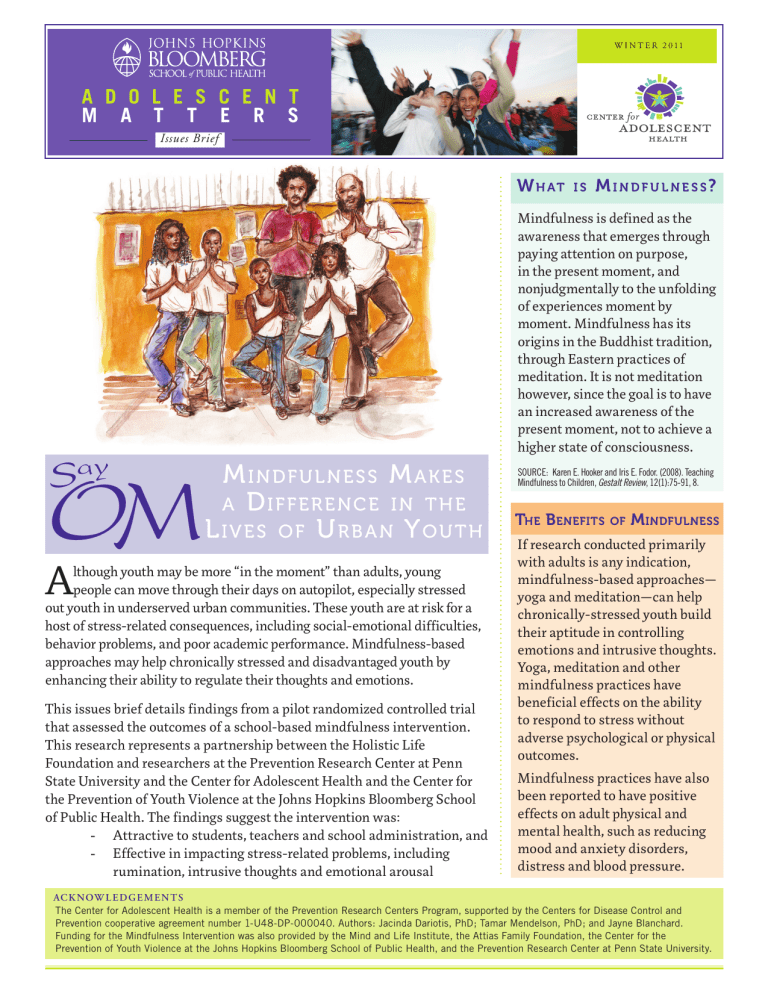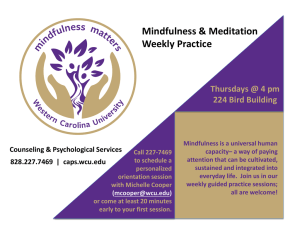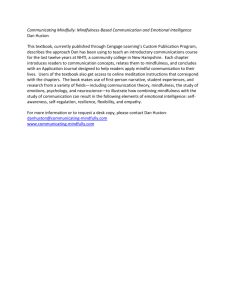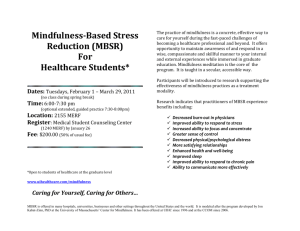Document 12464045

W I N T E R 2 0 11
A D O L E S C E N T
M A T T E R S
Issues Brief
W h at i s
M i n d f u l n e s s
?
Mindfulness is defined as the awareness that emerges through paying attention on purpose, in the present moment, and nonjudgmentally to the unfolding of experiences moment by moment. Mindfulness has its origins in the Buddhist tradition, through Eastern practices of meditation. It is not meditation however, since the goal is to have an increased awareness of the present moment, not to achieve a higher state of consciousness.
SOURCE: Karen E. Hooker and Iris E. Fodor. (2008). Teaching
Mindfulness to Children, Gestalt Review , 12(1):75-91, 8.
S ay OM M i n d f u l n e s s
M a k e s a
d i f f e r e n c e i n t h e l i v e s o f
u r b a n
Y o u t h
A lthough youth may be more “in the moment” than adults, young people can move through their days on autopilot, especially stressed out youth in underserved urban communities. These youth are at risk for a host of stress-related consequences, including social-emotional difficulties, behavior problems, and poor academic performance. Mindfulness-based approaches may help chronically stressed and disadvantaged youth by enhancing their ability to regulate their thoughts and emotions.
This issues brief details findings from a pilot randomized controlled trial that assessed the outcomes of a school-based mindfulness intervention.
This research represents a partnership between the Holistic Life
Foundation and researchers at the Prevention Research Center at Penn
State University and the Center for Adolescent Health and the Center for the Prevention of Youth Violence at the Johns Hopkins Bloomberg School of Public Health. The findings suggest the intervention was:
- Attractive to students, teachers and school administration, and
- Effective in impacting stress-related problems, including rumination, intrusive thoughts and emotional arousal t he
B enefits of
M indfulness
If research conducted primarily with adults is any indication, mindfulness-based approaches— yoga and meditation—can help chronically-stressed youth build their aptitude in controlling emotions and intrusive thoughts.
Yoga, meditation and other mindfulness practices have beneficial effects on the ability to respond to stress without adverse psychological or physical outcomes.
Mindfulness practices have also been reported to have positive effects on adult physical and mental health, such as reducing mood and anxiety disorders, distress and blood pressure.
ACK NOW L E DGE M E N TS
The Center for Adolescent Health is a member of the Prevention Research Centers Program, supported by the Centers for Disease Control and
Prevention cooperative agreement number 1-U48-DP-000040. Authors: Jacinda Dariotis, PhD; Tamar Mendelson, PhD; and Jayne Blanchard.
Funding for the Mindfulness Intervention was also provided by the Mind and Life Institute, the Attias Family Foundation, the Center for the
Prevention of Youth Violence at the Johns Hopkins Bloomberg School of Public Health, and the Prevention Research Center at Penn State University.
Issues Brief A D O L E S C E N T M A T T E R S W I N T E R 2 0 11 s t r e s s e d
o u t
k i d s
Poverty stresses out youth. How young people learn to manage stress can greatly affect their well-being, relations with others, and success in school and life.
Poverty and neighborhood risks have many repercussions, and if youth are not supported, it may lead to a pathway pitted with poor performance in school, dropping out of school, depression, mental health problems, alcohol and drug use, and risky sexual behaviors.
effect of chronic stress on the body—especially the cardiovascular system.
Persistently stressed children are vulnerable to difficulties in learning how to effectively regulate their thoughts and emotions. Emerging evidence has found that childhood adversity triggers neurobiological events that can alter brain development, potentially impairing the stress response systems. Consistent with this biological research, being exposed to multiple poverty-related risks increases the chance that children will have more difficulty controlling their emotions.
One reaction to stress is a style of thinking linked to anxiety and depression, which includes rumination and intrusive thoughts. Rumination, which is defined as negative, brooding, or obsessive thoughts, has been associated with depression and anxiety symptoms in young people. Both reactions can contribute to allostatic load, the cumulative
The word “yoga” conjures images of well-heeled suburbanites and superstars—think Madonna and
Sting as celebrity practitioners— doing downward dog pose in designer duds and perspiring delicately in poshly appointed studios.
West Baltimore’s Ali and Atman
Smith, along with Andres Gonzalez, want to change the perception of yoga as exercise for the elite.
They believe in yoga for everyone, especially school kids from higherneed Baltimore neighborhoods.
Their non-profit company, the
Holistic Life Foundation ( www.
hlfinc.org
) is dedicated to the concept that yoga and mindfulness practices teach people how personal health is connected to the health of their environment. “Yoga can heal mind, body and spirit,” says Ali
Smith. “It can also build awareness of what you eat, the quality of the air you breathe, the toxins in the environment— and the ways they impact how you think and feel.”
Teaching stressed children how to regulate emotions may provide them with new skills that promote healthy stress-response systems in the brain and may also enable them to avoid the downward trajectory faced by many at-risk youth as they progress through adolescence into adulthood.
M e e t t h e
Y o g i s
The Holistic Life Foundation works extensively with youth in
Baltimore’s poorer neighborhoods, teaching yoga, mindfulness and breathing practices to help youth and adults with stress, positive coping techniques, and to give them a quiet space in their often turbulent lives.
The foundation collaborated with Penn State Prevention
Research Center and the Center for Adolescent Health in the yoga intervention pilot study at four Baltimore City schools. “We structured the classes so they included active poses and breathing, and at the end, mindfulness and relaxation techniques,” says
Ali Smith. “At the end, even the hyperactive boys in the classes were lying there and doing it.”
The Smith brothers and co-founder Gonzalez saw positive behavior changes during the
12-week intervention. “The most mischievous boys were calmer and more focused,” says Gonzalez. “The cool thing was that a lot of the kids went home and taught the yoga and breathing exercises to their parents.
And we’re talking some pretty stressed out households.” The Smith brothers grew up with yoga. “Our father had us meditating before school,” Atman said.
They met Gonzales at the
University of Maryland, College Park.
“We started asking questions about the problems of the world,” said Ali.
“But rather than sit back, we decided to do something about it.”
They started the Holistic Life
Foundation in 2001. In addition to the yoga in-school and after-school programs, the group also conducts a mentoring program, tutoring and homework assistance, and environmental advocacy projects.
Future plans include expanding the mindfulness intervention.
“When we started the program in West Baltimore, the kids thought yoga was the little guy from ‘Star
Wars,’” says Atman. “Now they see that yoga is the true meaning of the word ‘respect’—it helps you to see the light in people.”
Page 2
Issues Brief A D O L E S C E N T M A T T E R S W I N T E R 2 0 11 t h e
i n n ovat i v e
u r b a n
Y o u t h
i n t e rv e n t i o n
Prevention researchers from the Johns Hopkins Bloomberg School of Public Health and Pennsylvania State
University and practitioners from the Holistic Life Foundation developed and evaluated a mindfulnessbased intervention for youth. Most of the participating youth were African American and lived in low-income neighborhoods with high levels of violence.
The aim of the trial was to evaluate the feasibility and acceptability of the intervention and to measure how it improved the youth’s involuntary stress responses, mood and relationships with peers and teachers.
Participants
The trial included approximately 97 fourth and fifth graders in four Baltimore City public elementary schools. Fourth and fifth graders were selected to participate in order to enhance these students’ competencies before the often-difficult transition into early adolescence. Two schools were randomized to receive the 12week intervention and two other schools served as waitlist controls and did not receive the intervention until the pilot trial was completed.
Intervention
Components
Participants attended the mindfulness program during school hours four days per week for 12 weeks.
Each session lasted 45 minutes and fourth and fifth graders were taught together. Key components of the intervention centered on yoga-based physical activity, breathing techniques, and guided mindfulness practices.
In each class, youth were taught yoga-inspired postures and movement series, including bending, stretching and fluid movement. These exercises trained the youth to use their breath to center and calm themselves.
The instructors wove into the guided mindfulness practice information about topics such as identifying stressors, using mindfulness techniques to respond to stress, cultivating positive relationships with others, and keeping one’s mind and body healthy.
How We
Measured
Results
Involuntary stress responses were measured using
The Responses to Stress
Questionnaire, a youth self-report checklist that assesses how children respond to and cope with stress, rumination, intrusive thoughts, emotional arousal and impulsive action.
Depressive symptoms were measured with The
Short Mood and Feelings Questionnaire—Child
Version, a 13-item report scale assessing depressive symptoms experienced over the past two weeks.
Relations with peer and school were evaluated with
People in My Life, a self-report measure that gauges the relationships children have with their parents, friends, school, and neighborhood.
Whatever you are doing, ask yourself, “What’s the state of my mind?” – Dalai Lama, 1999
Page 3
Issues Brief W I N T E R 2 0 11 A D O L E S C E N T M A T T E R S
M i n d f u l n e s s
i n t e rv e n t i o n
o u tco M e s
St udents were ent husiast ic about t he program, w it h 73.5 percent of st udents at one inter vent ion school complet ing at least 75 percent of t he classes. Focus groups conducted w it h st udents and teachers indicated t hat t he st udents had a posit ive experience in t he program and learned skills t hat helped t hem in t heir day-to-day lives.
“Most important thing I learned in the program is that it’s all different ways to deal with your stress, like instead of f ighting and stuff.”
—5th grade boy
“It helps you relieve stress when you really feel stressed out or you’re really mad and focus on what’s inside of you and just make sure that you stay calm.”
—5th grade girl
“The program has helped me because now I know different routines and exercises that I can do at home that help me lower and reduces my stress. So whenever
I get stressed out I can just do a pose and sometimes I can show my mother and my family.”
—4th grade girl
Further focus groups revealed that teachers were uniformly supportive of the idea of training urban youth using yoga and mindfulness techniques, especially if they could aid students struggling with behavior problems, high activity level, and poor attention-focus. Some teachers noted that they observed improvements in their students.
The intervention group reported signif icant improvements on the overall responses to stress scale of Involuntary Engagement, compared to the control group. In addition, signif icant differences were found on three of the f ive subscales–rumination, intrusive thoughts, and emotional arousal.
The intervention group’s reduction in involuntary stress reactions suggests that mindfulness-based practices were effective in helping youth self-regulate their emotions and reduce worrying thoughts.
If you want to be happy, be.
– Henry David Thoreau
c o n c lu s i o n
Mindfulness-based approaches may be advantageous to urban youth by improving their capacity to cope with persistent stress. Enhancing responses to stress and the ability to control negative feelings and troubling thoughts among at-risk youth has the potential to encourage the development of core competencies that will benef it young people in school, at home and with friends, in the community— and throughout life.
Content for this Issues Brief is based on the following article: Mendelson, T., Greenberg, M.T., Dariotis, J.K., Feagans Gould, L.,
Rhoades, B.L. & Leaf, P.J. (2010). Feasibility and preliminary outcomes of a school-based mindfulness intervention for urban youth, Journal of
Abnormal Child Psychology, 38, 985-994. Retrieved on January 4, 2011 at http://www.springerlink.com/content/y574726332407006/
A RT CR E DIT All illustrations by Amy Feinberg DE SIGN CR E DIT Publication design by Denise Dalton
Issues Brief W I N T E R 2 0 11 A D O L E S C E N T M A T T E R S references
Andersen, S. L. (2003). Trajectories of brain development: point of vulnerability or window of opportunity? Neuroscience and Biobehavioral Reviews, 27, 3–18.
Andersen, S. L., & Teicher, M. H. (2009). Desperately driven and no brakes: developmental stress exposure and subsequent risk for substance use. Neuroscience and Behavioral
Reviews, 33, 516–524.
Angold, A., Costello, E. J., Messer, S. C., Pickles, A., Winder, F., & Silver, D. (1995). Development of a short questionnaire for use in epidemiological studies of depression in children and adolescents. International Journal of Methods in Psychiatric Research, 5, 237–249.
Arias, A. J., Steinberg, K., Banga, A., & Trestment, R. L. (2006). Systematic review of the efficacy of meditation techniques as treatments for medical illness. Journal of
Alternative and Complementary Medicine, 12, 817–832.
Benn, R. (2003). Transcendental meditation and emotional functioning in fifth-grade students. Focus on Alternative and Complementary Therapies, 8, 480–481.
Biegel, G. M., Brown, K. W., Shapiro, S. L., & Schubert, C. M. (2009). Mindfulness-based stress reduction for the treatment of adolescent psychiatric outpatients: A randomized clinical trial. Journal of Consulting and Clinical Psychology, 77, 855–866.
Bootzin, R. R., & Stevens, S. J. (2005). Adolescents, substance abuse, and the treatment of insomnia and daytime sleepiness. Clinical Psychology Review, 25,
629–644.
Cook, E. T., Greenberg, M. T., & Kusche, C. A. (March, 1995). People in my
life: Attachment relationships in middle childhood. Paper presented at the Society for
Research in Child Development; Indianapolis, IN.
Brefczynski-Lewis, J. A., Lutz, A., Schaefer, H. S., Levinson, D. B., & Davidson,
R. J. (2007). Neural correlates of attentional expertise in long-term meditation practitioners. Proceedings of the National Academy of Sciences of the United States of
America, 104, 11483–11488.
Evans, G. W., Pilyoung, K., Albert, H., Tesher, H. B., & Shannis, D. (2007).
Cumulative risk, maternal responsiveness, and allostatic load among young adolescents. Developmental Psychology, 43, 341–351.
Brosschot, J. F., Pieper, S., & Thayer, J. F. (2005). Expanding stress theory: prolonged activation and perseverative cognition. Psychoneuroendocrinology, 30,
1043–1049.
Brosschot, J. F., Gerin, W., & Thayer, J. F. (2006). The perseverative cognition hypothesis: a review of worry, prolonged stress-related physiological activation, and health. Journal of Psychosomatic Research, 60, 113–124.
Brown, K. W., & Ryan, R. M. (2003). The benefits of being present: mindfulness and its role in psychological well-being.
Journal of Personality and Social Psychology,
84, 822–848.
Carter, O. L., Presti, D. E., Callistemon,
C., Ungerer, Y., Liu, G. B., & Pettigrew,
J. D. (2005). Meditation alters perceptual rivalry in Tibetan Buddhist monks. Current Biology, 15, R412–413.
Cheung, M. W.-L., & Au, K. (2005).
Applications of multilevel structural equation modeling to cross-cultural research. Structural Equation Modeling,
12, 598–619.
Clarke, G. N., Hawkins, W., Murphy,
M., Sheeber, L. B., Lewinsohn, P. M., &
Seeley, J. R. (1995). Targeted prevention of unipolar depressive disorder in an at-risk sample of high school adolescents: a randomized trial of a group cognitive intervention. Journal of the American Academy of Child and Adolescent
Psychiatry, 34, 312–321.
Floriani, V., & Kennedy, C. (2008). Promotion of physical activity in children.
Current Opinion in Pediatrics, 20, 90–95.
Galantino, M. L., Galbavy, R., & Quinn, L. (2008). Therapeutic effects of yoga for children: a systematic review of the literature. Pediatric Physical Therapy, 20, 66–80.
Gerin, W., Davidson, K. W., Christenfeld, N. J., Goyal, T.,
& Schwartz, J. E. (2006). The role of angry rumination and distraction in blood pressure recovery from emotional arousal. Psychosomatic Medicine, 68,
64–72.
Afflictive emotions—our jealousy, anger, hatred, fear—can be put to an
Grant, K. E., Lyons, A. L., Finkelstein,
J. S., Conway, K. M.,Reynolds, L. K.,
O’Koon, J. H., et al. (2004). Gender differences in rates of depressive symptoms among low-income, urban,
African American youth: a test of two mediational hypotheses. Journal of Youth
and Adolescence, 33, 523–533.
end when you realize that these emotions are only temporary, that they always pass on like clouds in the sky.
– Dalai Lama, 1999
Grant, L. E., Compas, B. E., Thurm,
A. E., McMahon, S. D., Gipson,
P. Y., Campbell, A. J., et al. (2006).
Stressors and child and adolescent psychopathology: evidence of moderating and mediating effects.
Clinical Psychology Review, 26, 257–283.
Greenberg, M. T. (2006). Promoting resilience in children and youth: preventive interventions and their interface with neuroscience. Annals of
the New York Academy of Science, 1094,
139–150.
Compas, B. E., Connor, J. K., Saltzman,
H., Thomsen, A. H., & Wadsworth, M. (1999).
Getting specific about coping: Effortful and involuntary responses to stress in development. In M. Lewis & D. Ramey (Eds.), Stress and soothing (pp. 229–256).
New Jersey: Lawrence Erlbaum Associates, Inc.
Guerra, N. G., & Bradshaw, C. P. (2008).
Linking the prevention of problem behaviors and positive youth development: Core competencies for positive youth development and risk prevention. In
N. G. Guerra & C. P. Bradshaw (Eds.), Core competencies to prevent problem behaviors and
promote positive youth development. New Directions for Child and Adolescent Development, 122,
1–17.
Compas, B. E., Connor-Smith, J. K., Saltzman, H., Thomsen, A. H., &
Wadsworth, M. E. (2001). Coping with stress during childhood and adolescence: problems, progress, and potential in theory and research. Psychological Bulletin, 127,
87–127.
Connor-Smith, J. K., Compas, B. E., Wadsworth, M. E., Tomsen, A.H., & Saltzman,
H. (2000). Responses to stress in adolescence: measurement of coping and involuntary stress responses. Journal of Consulting and Clinical Psychology, 68, 976–992.
Hox, J. J. (1995). Applied multi-level analysis (2nd ed.). Amsterdam: TT-Publikaties.
Jha, A. P., Krompinger, J., & Baime, M. J. (2007). Mindfulness training modifies subsystems of attention. Cognitive, Affective, and Behavioral Neuroscience, 7, 109–119.
Keenan, K., Shaw, D. S., Walsh, S., Delliquadri, E., & Giovanelli, J. (1997). DSM-
III-R disorders in pre-school children from low income families. Journal of the
American Academy of Child and Adolescent Psychiatry, 36, 620–627.
Page 5
Issues Brief A D O L E S C E N T M A T T E R S W I N T E R 2 0 11
Kendall, P. C., Flannery-Schroeder, E., Panichelli-Mindel, S. M., Southam-Gerow, M., Henin, A., & Warman, M. (1997). Therapy for youths with anxiety disorders: a second randomized clinical trial. Journal of Consulting and Clinical Psychology, 65, 366–380.
Key, B. L., Campbell, T. S., Bacon, S. L., & Gerin, W. (2008). The influence of trait and state rumination on cardiovascular recovery from a negative emotional stressor.
Journal of Behavioral Medicine, 31, 237–248.
Kirkwood, G., Rampes, H., Tuffrey, V., Richardson, J., & Pilkington, K. (2005). Yoga for anxiety: a systematic review of the research evidence. British Journal of Sports
Medicine, 39, 884–891.
Lazar, S. W., Kerr, C. E., Wasserman, R. H., Gray, J. R., Greve, D. N., Treadway, M. T., et al. (2005). Meditation experience is associated with cortical thickness. Neuroreport, 16, 1893–1897.
McEwen, B. S., & Seeman, T. E. (1999). Protective and damaging effects of mediators of stress: Elaborating and testing the concept of allostasis and allostatic load. In N. E.
Adler, M. Marmot, B. S. McEwen, & J. Stewart (Eds.), Socioeconomic status and health in industrial nations (pp. 30–47). New York: New York Academy of Sciences.
Mendelson, T., Greenberg, M.T., Dariotis, J.K., Feagans Gould, L., Rhoades, B.L. & Leaf, P.J. (2010). Feasibility and preliminary outcomes of a school-based mindfulness intervention for urban youth, Journal of Abnormal Child Psychology, 38, 985-994.
Murray, C., & Greenberg, M. T. (2000). Children’s relationship with teachers and bonds with school: an investigation of patterns and correlates in middle childhood.
Journal of School Psychology, 38, 423–445.
Semple, R. J., Reid, E. F. G., & Miller, L. (2005). Treating anxiety with mindfulness: an open trial of mindfulness training for anxious children. Journal of
Cognitive Psychotherapy: An International Quarterly, 19, 379–392.
Murray,D.M., Varnell, S. P.,&Blitstein, J. S. (2004).Design and analysis of grouprandomized trials: a review of recent methodological developments. American Journal of
Public Health, 94, 423–432.
Napoli, M., Krech, P. R., & Holley, L. C. (2005). Mindfulness training for elementary school students: the attention academy. Journal of Applied School Psychology, 21, 99–125.
National Research Council and Institute of
Medicine. (2009). Preventing mental emotional, and behavioral disorders among young people. Progress
and possibilities. Washington, D.C.: The
National Academies.
Nolen-Hoeksema, S. (1991). Responses to depression and their effects on the duration of depressive episodes. Journal
of Abnormal Psychology, 100, 569–582.
Nolen-Hoeksema, S.,Wisco, B.
E.,&Lyubomirsky, S. (2008). Rethinking rumination. Perspectives on Psychological
Science, 3, 400–424.
Ospina, M. B., Bond, K., Karkhaneh,
M., Tjosvold, L., Vandermeer, B., Liang,
Y., et al. (2007). Meditation practices for health: state of the research. Evidence
Report/Technology Assessment (Full Report),
155, 1–263.
Shapiro, S. L., Brown, K. W., & Biegel, G. M. (2007). Teaching selfcare to caregivers: effects of mindfulness-based stress reduction on the mental health of therapists in training. Training and Education in Professional Psychology, 1, 105–115.
The only journey is the journey within.
Shonkoff, J. P., Boyce, W. T., & McEwen, B. S. (2009).
Neuroscience, molecular biology, and the childhood
– Rainer Maria Rilke
Pate, R. R., Trost, S. G., Levin, S., &
Dowda, M. (2000). Sports participation and health-related behaviors among U.S. youth. Archives of Pediatric and Adolescent
Medicine, 154, 904–911.
Pentz, M. A. (2008, June). Translating drug use
prevention to obesity prevention. Paper presented at the
National Institute on Drug Abuse Science Meeting,
“Can Physical Activity and Exercise Prevent Drug Abuse?” Bethesda, MD.
Pilkington, K., Kirkwood, G., Rampes, H., & Richardson, J. (2005). Yoga for depression: the research evidence. Journal of Affective Disorders, 89, 13–24.
Reynolds, A. J., Temple, J. A., Robertson, D. L., & Mann, E. A. (2001). Long-term effects of an early childhood intervention on educational achievement and juvenile arrest: a 15-year follow-up of low-income children in public schools. Journal of the
American Medical Association, 285, 2339–2346.
Roelofs, J., Rood, L., Meesters, C., Te Dorsthorst, V., Bogels, S., Alloy, L. B., et al.
(2009). The influence of rumination and distraction on depressed and anxious mood: a prospective examination or the response styles theory in children and adolescents.
European Child and Adolescent Psychiatry, 18, 635–642.
Sandler, I. N., Tein, J. Y., Mehta, P., Wolchik, S., & Ayers, T. (2000). Coping efficacy and psychological problems of children of divorce. Child Development, 71, 1099–1118.
roots of health disparities. Building a new framework for health promotion and disease prevention. Journal of the American Medical
Association, 301, 2252–2259.
Srinivasan, N., & Baijal, S. (2007).
Concentrative meditation enhances preattentive processing: a mismatch negativity study. Neuroreport, 18,
1709–1712.
Ströhle, A., Höfler, M., Pfister, H.,
Müller, A. G., Hoyer, J., Wittchen,
H. U., et al. (2007). Physical activity and prevalence and incidence of mental disorders in adolescents and young adults. Psychological Medicine, 37,
1657–1666.
Teicher, M. H., Andersen, S. L.,
Polcari, A., Anderson, C. M., &
Navalta, C. P. (2002). Developmental neurobiology of childhood stress and trauma. Psychiatric Clinics of North
America, 25, 397–426
Wadsworth, M. E., Raviv, T., Compas,
B. E., & Connor-Smith, J. K. (2005).
Parent and adolescent responses to poverty-related stress: tests of mediated and moderated coping models. Journal of
Child and Family Studies, 14, 283–298.
Wall, R. B. (2005). Tai chi and mindfulness-based stress reduction in a Boston public middle school. Journal of Pediatric Health Care,
19, 230–237.
West, J., Denton, K., & Reaney, L. M. (2001). The kindergarten year: Findings from the
Early Childhood Longitudinal Study, kindergarten class of 1998–1999 (Publication No.
NCES2001-023). Washington, DC: Department of Education, National Center for Education Statistics.
Windle, M., Spear, L. P., Fuligni, A. J., Angold, A., Brown, J. D., Pine, D., et al.
(2008). Transitions into underage and problem drinking: developmental processes and mechanisms between 10 and 15 years of age. Pediatrics, 121(Suppl. 4), S273–
S289.
Wolchik, S. A., Tein, J. Y., Sandler, I. N., & Ayers, T. S. (2006). Stressors, quality of the child-caregiver relationship, and children’s mental health problems after parental death: the mediating role of self-system beliefs. Journal of Abnormal Child
Psychology, 34, 221–238.
Johns Hopkins Bloomberg School of Public Health
Department of Population, Family and Reproductive Health
615 N. Wolfe Street, Baltimore, MD 21205 Phone 443.287.3012
www.jhsph.edu/adolescenthealth





